Apollo - Soyuz Dragon 1/72
Discussion
Last year I built Dragon's nice little 1/72 Gemini spacecraft. Now that I have the time to get back to a model building project, I thought another Dragon space kit would be rewarding to tackle.
2015 was the 40th Anniversary of the Apollo-Soyuz Test Project (ASTP) - which took place in July 1975. It was a political mission as much as engineering, scientific or technological and had been dreamed up by President Richard Nixon as part of his "détente" programme with the Soviet Union. Originally, they had looked at the idea of a Soyuz docking with a Skylab space station or an Apollo docking with a Salyut. In the end, they went for a simpler option by having an Apollo and Soyuz dock with each other.
Ironically, by the time the mission flew, Nixon had resigned in disgrace and it was left to President Ford to garner any positive PR from the events.
It was the last ever mission using Apollo hardware. The next US manned spaceflight was the first Space Shuttle mission in April 1981.
A few months ago I purchased Dragon's 1/72 kit of the ASTP. Dragon has produced a whole raft of Apollo based kits. Almost all of them feature the same Command/Service Module - which is no surprise as this spacecraft was intrinsic to all of the manned Apollo flights.
As far as I am aware, it is the only mainstream injection moulded kit of the Block 2 Command/Service Module and it certainly looks accurate enough to me.
The Soyuz spacecraft that is included in the package is resin rather than polystyrene - which is an odd choice of material. However, as you can see from the pictures, it results in a very simple model. The one part of the Soyuz that I am not entirely happy with is the depiction of the solar panels. A blue coloured "sticker" is provided which is supposed to replicate the look of the solar cells but I think it is far too blue and garish and I plan to try an alternative less brash way of showing these panels. I haven't quite worked out how yet
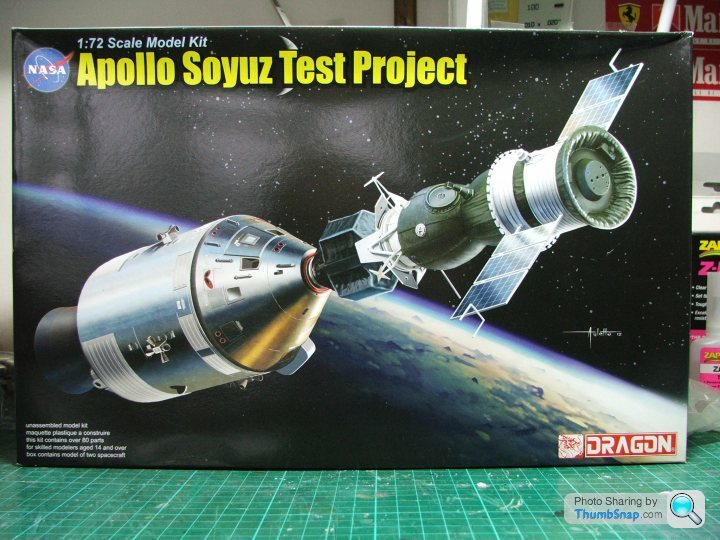
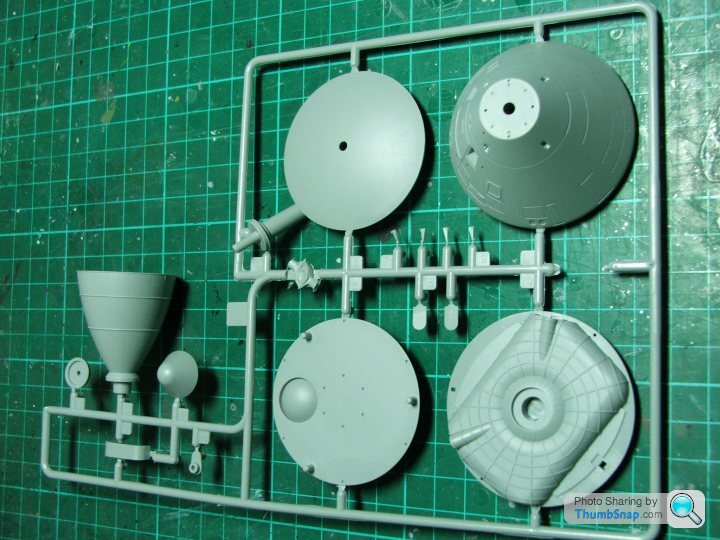
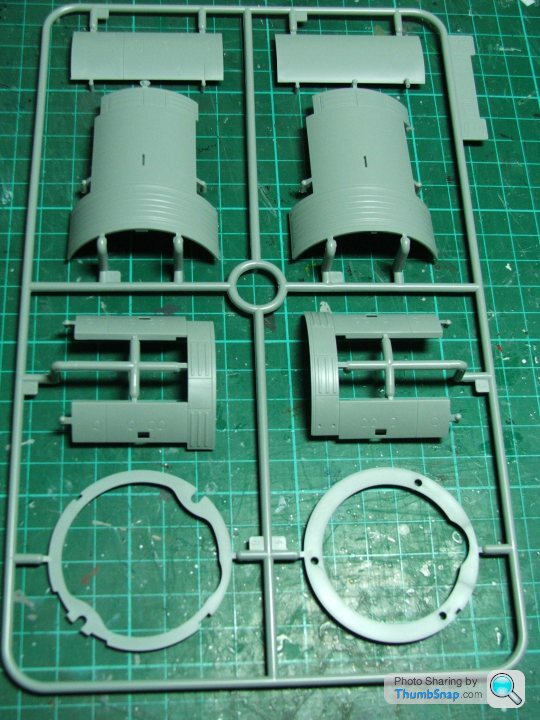
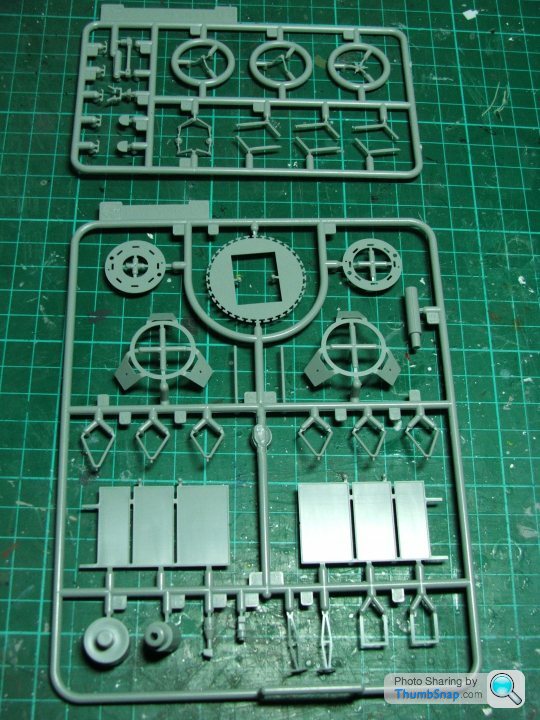
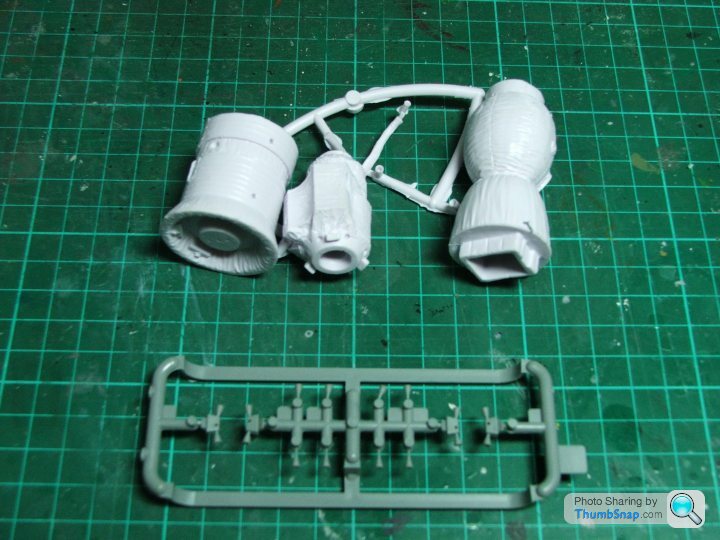
2015 was the 40th Anniversary of the Apollo-Soyuz Test Project (ASTP) - which took place in July 1975. It was a political mission as much as engineering, scientific or technological and had been dreamed up by President Richard Nixon as part of his "détente" programme with the Soviet Union. Originally, they had looked at the idea of a Soyuz docking with a Skylab space station or an Apollo docking with a Salyut. In the end, they went for a simpler option by having an Apollo and Soyuz dock with each other.
Ironically, by the time the mission flew, Nixon had resigned in disgrace and it was left to President Ford to garner any positive PR from the events.
It was the last ever mission using Apollo hardware. The next US manned spaceflight was the first Space Shuttle mission in April 1981.
A few months ago I purchased Dragon's 1/72 kit of the ASTP. Dragon has produced a whole raft of Apollo based kits. Almost all of them feature the same Command/Service Module - which is no surprise as this spacecraft was intrinsic to all of the manned Apollo flights.
As far as I am aware, it is the only mainstream injection moulded kit of the Block 2 Command/Service Module and it certainly looks accurate enough to me.
The Soyuz spacecraft that is included in the package is resin rather than polystyrene - which is an odd choice of material. However, as you can see from the pictures, it results in a very simple model. The one part of the Soyuz that I am not entirely happy with is the depiction of the solar panels. A blue coloured "sticker" is provided which is supposed to replicate the look of the solar cells but I think it is far too blue and garish and I plan to try an alternative less brash way of showing these panels. I haven't quite worked out how yet






How long is the completed kit?
My dad has a couple of space-related kits so if its not too big I may seek this out as a present for him. Mind you he's probably not too pleased with the last space(ish) kit I bought him, I got the Revell 1/144 Boeing 747 & Space Shuttle as a Christmas present, stating that "I'd like it myself but don't have the space for it. I know you don't either but that's not my problem!" I do hope it doesn't just sit in its box unbuilt though, but it is quite a size.
As for the colour for the solar panels, I seem to recall using a Humbrol electric blue colour for the panels on the ISS and Mir kits I did as a kid, they were a bit bright but perhaps with some mixing with a darker blue might create a better shade?
My dad has a couple of space-related kits so if its not too big I may seek this out as a present for him. Mind you he's probably not too pleased with the last space(ish) kit I bought him, I got the Revell 1/144 Boeing 747 & Space Shuttle as a Christmas present, stating that "I'd like it myself but don't have the space for it. I know you don't either but that's not my problem!" I do hope it doesn't just sit in its box unbuilt though, but it is quite a size.
As for the colour for the solar panels, I seem to recall using a Humbrol electric blue colour for the panels on the ISS and Mir kits I did as a kid, they were a bit bright but perhaps with some mixing with a darker blue might create a better shade?
There are no dimensions shown on the box but measuring the main components I get a length of 26 cm.
I've come across one error in the Command/Service Module - the engine bell of the Service Module.
For some reason, nearly all the kit manufacturers have not got the engine bell detail right. This kit is no exception as it shows two rings around the bell. In reality there was only one.
In the past NASA were partly to blame for this because they released many diagrams and drawings of Service Modules showing two or sometimes even three rings on the bell. Back in the 1960s and 70s, you could perhaps excuse kit manufacturers for relying on these incorrect drawings. 40 odd years after the last Apollo flight with hundreds of pictures of real Service Modules available, Dragon has less of an excuse for getting it wrong.
In the picture below you can see the incorrect engine nozzle. This is from another website and is not the actual kit I am building - but the Command/Service Module is the same.

Here's a picture of a real one -

I've come across one error in the Command/Service Module - the engine bell of the Service Module.
For some reason, nearly all the kit manufacturers have not got the engine bell detail right. This kit is no exception as it shows two rings around the bell. In reality there was only one.
In the past NASA were partly to blame for this because they released many diagrams and drawings of Service Modules showing two or sometimes even three rings on the bell. Back in the 1960s and 70s, you could perhaps excuse kit manufacturers for relying on these incorrect drawings. 40 odd years after the last Apollo flight with hundreds of pictures of real Service Modules available, Dragon has less of an excuse for getting it wrong.
In the picture below you can see the incorrect engine nozzle. This is from another website and is not the actual kit I am building - but the Command/Service Module is the same.

Here's a picture of a real one -

I think that would be too blue. Looking at pictures of the Soyuz actually used on the mission, the panels look more "grey" than "blue".
The Soyuz used in 1975 was a bit of a one off. The very first Soyuz missions featured craft with solar panels - but the panels were actually cranked mid way along their span - making them look a bit like a Stuka or a Corsair.
When the Soyuz started being used as a space station ferry craft (from 1971), they did not bother with solar panels and relied on internal batteries only.
Because the Apollo-Soyuz mission required a Soyuz flying for a number of days having to use its own power, it was decided to reinstate solar panels. However, they did not feature that gull wing shape.
In the 1980s, the newer Soyuz TM and later TMA craft all had/have solar panels, but they were different again.
So, the only pictures of panels you can rely on for the Soyuz used on the Apollo/Soyuz joint flight are pictures of that particular Soyuz.
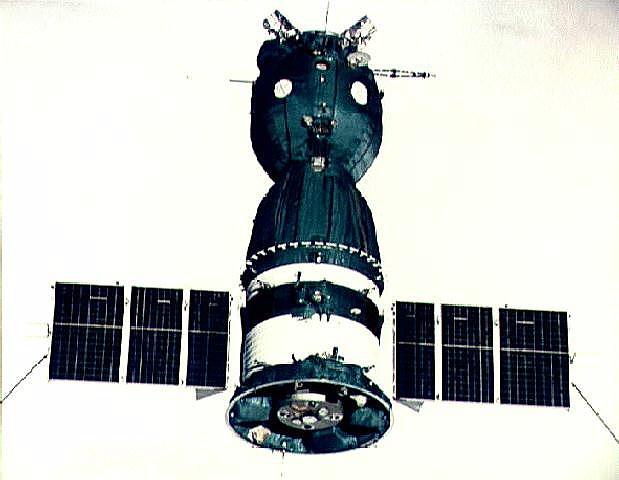
The Soyuz used in 1975 was a bit of a one off. The very first Soyuz missions featured craft with solar panels - but the panels were actually cranked mid way along their span - making them look a bit like a Stuka or a Corsair.
When the Soyuz started being used as a space station ferry craft (from 1971), they did not bother with solar panels and relied on internal batteries only.
Because the Apollo-Soyuz mission required a Soyuz flying for a number of days having to use its own power, it was decided to reinstate solar panels. However, they did not feature that gull wing shape.
In the 1980s, the newer Soyuz TM and later TMA craft all had/have solar panels, but they were different again.
So, the only pictures of panels you can rely on for the Soyuz used on the Apollo/Soyuz joint flight are pictures of that particular Soyuz.

Finally managed to complete this project -
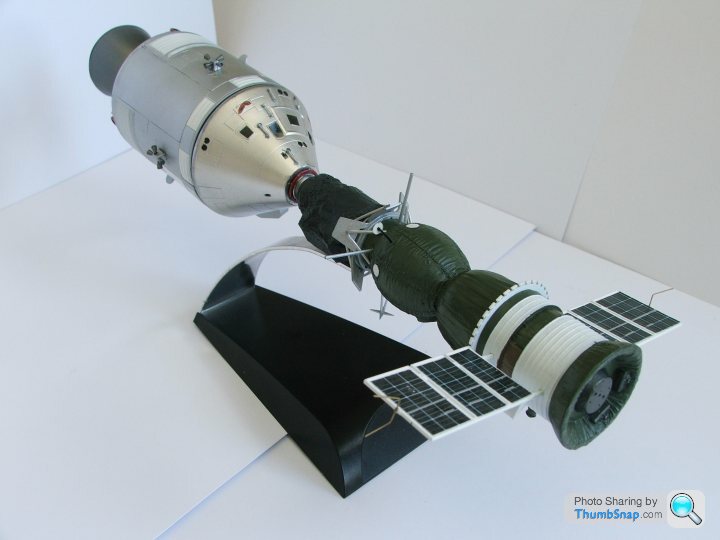
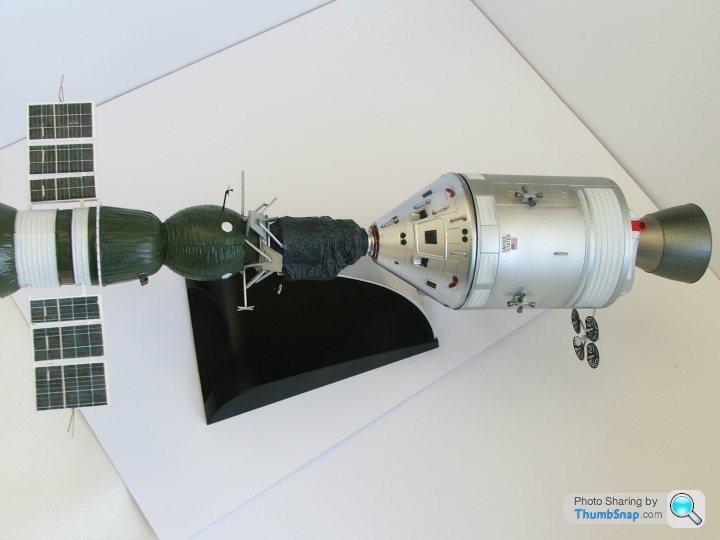
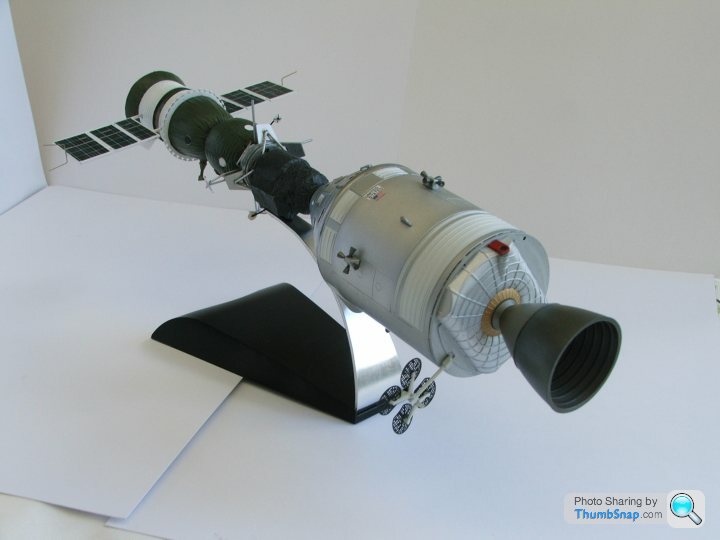

Even though it's a very modern kit (2012) it still had its issues - particularly with the instructions which not only were incomplete, in some areas showed a part that was not quite how it actually looked in the box. I relied very heavilly on an article in Airfix Model World magazine, especially regarding the assembly of the Soyuz.
Still, I'm quite proud of it and it's nice to have a representation of a unique moment in spaceflight history in my collection.




Even though it's a very modern kit (2012) it still had its issues - particularly with the instructions which not only were incomplete, in some areas showed a part that was not quite how it actually looked in the box. I relied very heavilly on an article in Airfix Model World magazine, especially regarding the assembly of the Soyuz.
Still, I'm quite proud of it and it's nice to have a representation of a unique moment in spaceflight history in my collection.
Thank you. It was an interesting model to build, not just because of the subject matter but also because of the massive difference between the two elements i.e. the Soyuz and the Apollo. The Soyuz bit weighs around four times more than the Apollo bit as it is made from a much denser medium.
As far as the real things is concerned, what really stands out is how tiny the Soyuz re-entry module is compared to the Apollo Command Module.
As far as the real things is concerned, what really stands out is how tiny the Soyuz re-entry module is compared to the Apollo Command Module.
Very Nice Eric! I can see why they used resin for the Soyuz, those creases and folds would have been a nightmare to injection mould nicely without splitting the model in to lots of radial sections to avoid undercuts. The resin allows a much more natural effect.
Are you at Telford this year? Not long now!
Are you at Telford this year? Not long now!
lufbramatt said:
Very Nice Eric! I can see why they used resin for the Soyuz, those creases and folds would have been a nightmare to injection mould nicely without splitting the model in to lots of radial sections to avoid undercuts. The resin allows a much more natural effect.
Are you at Telford this year? Not long now!
I most certainly will be at Telford. The Soyuz-Apollo model might be on display on the NASA SIG stand - if they allow me to display it.Are you at Telford this year? Not long now!
Gassing Station | Scale Models | Top of Page | What's New | My Stuff






